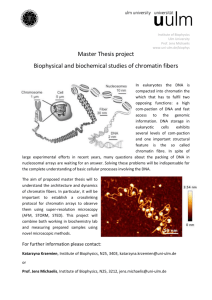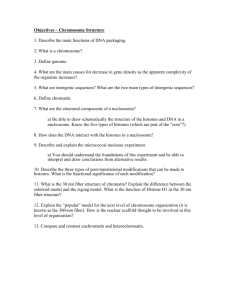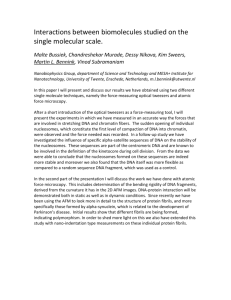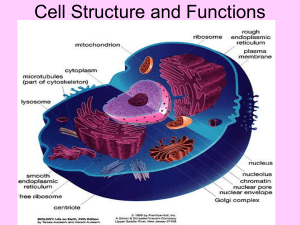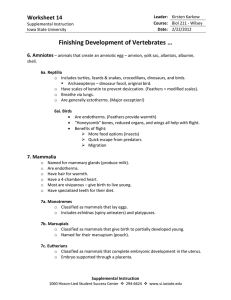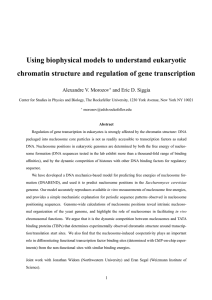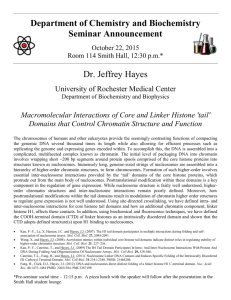in vitro in silico experiments chlick*‡
advertisement
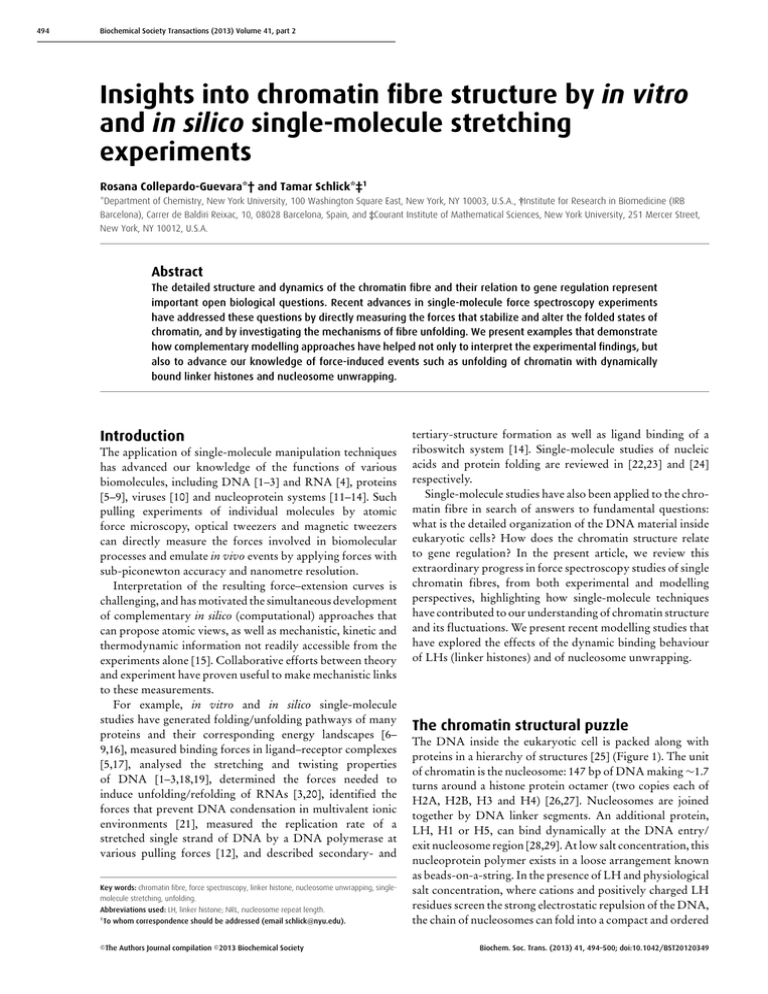
494 Biochemical Society Transactions (2013) Volume 41, part 2 Insights into chromatin fibre structure by in vitro and in silico single-molecule stretching experiments Rosana Collepardo-Guevara*† and Tamar Schlick*‡1 *Department of Chemistry, New York University, 100 Washington Square East, New York, NY 10003, U.S.A., †Institute for Research in Biomedicine (IRB Barcelona), Carrer de Baldiri Reixac, 10, 08028 Barcelona, Spain, and ‡Courant Institute of Mathematical Sciences, New York University, 251 Mercer Street, New York, NY 10012, U.S.A. Abstract The detailed structure and dynamics of the chromatin fibre and their relation to gene regulation represent important open biological questions. Recent advances in single-molecule force spectroscopy experiments have addressed these questions by directly measuring the forces that stabilize and alter the folded states of chromatin, and by investigating the mechanisms of fibre unfolding. We present examples that demonstrate how complementary modelling approaches have helped not only to interpret the experimental findings, but also to advance our knowledge of force-induced events such as unfolding of chromatin with dynamically bound linker histones and nucleosome unwrapping. Introduction The application of single-molecule manipulation techniques has advanced our knowledge of the functions of various biomolecules, including DNA [1–3] and RNA [4], proteins [5–9], viruses [10] and nucleoprotein systems [11–14]. Such pulling experiments of individual molecules by atomic force microscopy, optical tweezers and magnetic tweezers can directly measure the forces involved in biomolecular processes and emulate in vivo events by applying forces with sub-piconewton accuracy and nanometre resolution. Interpretation of the resulting force–extension curves is challenging, and has motivated the simultaneous development of complementary in silico (computational) approaches that can propose atomic views, as well as mechanistic, kinetic and thermodynamic information not readily accessible from the experiments alone [15]. Collaborative efforts between theory and experiment have proven useful to make mechanistic links to these measurements. For example, in vitro and in silico single-molecule studies have generated folding/unfolding pathways of many proteins and their corresponding energy landscapes [6– 9,16], measured binding forces in ligand–receptor complexes [5,17], analysed the stretching and twisting properties of DNA [1–3,18,19], determined the forces needed to induce unfolding/refolding of RNAs [3,20], identified the forces that prevent DNA condensation in multivalent ionic environments [21], measured the replication rate of a stretched single strand of DNA by a DNA polymerase at various pulling forces [12], and described secondary- and Key words: chromatin fibre, force spectroscopy, linker histone, nucleosome unwrapping, singlemolecule stretching, unfolding. Abbreviations used: LH, linker histone; NRL, nucleosome repeat length. 1 To whom correspondence should be addressed (email schlick@nyu.edu). C The C 2013 Biochemical Society Authors Journal compilation tertiary-structure formation as well as ligand binding of a riboswitch system [14]. Single-molecule studies of nucleic acids and protein folding are reviewed in [22,23] and [24] respectively. Single-molecule studies have also been applied to the chromatin fibre in search of answers to fundamental questions: what is the detailed organization of the DNA material inside eukaryotic cells? How does the chromatin structure relate to gene regulation? In the present article, we review this extraordinary progress in force spectroscopy studies of single chromatin fibres, from both experimental and modelling perspectives, highlighting how single-molecule techniques have contributed to our understanding of chromatin structure and its fluctuations. We present recent modelling studies that have explored the effects of the dynamic binding behaviour of LHs (linker histones) and of nucleosome unwrapping. The chromatin structural puzzle The DNA inside the eukaryotic cell is packed along with proteins in a hierarchy of structures [25] (Figure 1). The unit of chromatin is the nucleosome: 147 bp of DNA making ∼1.7 turns around a histone protein octamer (two copies each of H2A, H2B, H3 and H4) [26,27]. Nucleosomes are joined together by DNA linker segments. An additional protein, LH, H1 or H5, can bind dynamically at the DNA entry/ exit nucleosome region [28,29]. At low salt concentration, this nucleoprotein polymer exists in a loose arrangement known as beads-on-a-string. In the presence of LH and physiological salt concentration, where cations and positively charged LH residues screen the strong electrostatic repulsion of the DNA, the chain of nucleosomes can fold into a compact and ordered Biochem. Soc. Trans. (2013) 41, 494–500; doi:10.1042/BST20120349 Topological Aspects of DNA Function and Protein Folding Figure 1 Representation of the hierarchical folding states of the chromatin fibre DNA is in red, alternating nucleosomes are in white and blue, tails are in green, and LHs are in cyan. 30-nm chromatin fibre, although the existence of this longassumed state has been questioned [30,31,31a]. The organization of the DNA into chromatin serves two antagonistic biological functions. Whereas condensation allows the metres-long genome to be packed inside micrometre-sized nuclei, it also obscures access to the DNA by the cellular machinery involved in the regulation of DNA transcription, replication and repair. Understanding the structure and dynamics of chromatin is thus essential to fully comprehend these fundamental template-directed processes. Among the models proposed for the 30-nm fibre are the zigzag or two-start structure [32], in which consecutive nucleosomes criss-cross the fibre axis and are connected by straight DNA linkers, and the solenoid or one-start helix [33], in which immediate nucleosome neighbours lie next to each other connected by highly bent DNA linkers. Many variants and extensions of these models exist, including interdigitated solenoid [34,35], three-start helix [36], superbead [37] and heteromorphic [38] models. Experimental and modelling techniques have identified several key factors that modify the structure of the chromatin fibre and favour one model over another. These factors include the length of the DNA linker segments [measured in terms of the NRL (nucleosome repeat length), the 147 bp of DNA wrapped around the histone octamer plus the length of the DNA linker connecting adjacent nucleosomes], the binding of LHs, the monovalent salt concentration and the presence of divalent ions (for a recent review, see [25]). In fact, EM (electron microscopy)-assisted nucleosome interaction capture experiments combined with mesoscale modelling suggested that divalent ions promote some DNA-linker bending and trigger a more variable heteromorphic chromatin organization that combines features of the zigzag and solenoid models [38]. Such heteromorphic fibres have gained popularity recently based on a variety of experimental and computational techniques [25]. See also [39] for an excellent review. Force spectroscopy experiments of single chromatin fibres Single chromatin force spectroscopy techniques provide novel structural information to explore further these intriguing questions (see comprehensive reviews in [40] and [41]). A mechanical deformation of individual chromatin fibres is achieved by fixing the position of one of its ends, while stretching or twisting the other end at a constant force or up to a fixed position; the ends of the chromatin fibre are normally defined as those of long flanking DNA segments attached to the fibre’s termini, or as the first and last nucleosomes. These techniques have been applied to examine the forces needed to disrupt the chromatin folded state and analyse the fibre’s behaviour under tension. The pulling forces used, typically up to 40 pN, imitate those applied by molecular machines under in vivo conditions, such as DNA and RNA polymerase that exert forces of up to 35 pN [42]. The folded state of the chromatin fibre is mainly stabilized by electrostatic interactions. Indeed, relatively high ionic concentrations (above ∼0.10 M NaCl) to shield the strong DNA-linker–DNA-linker electrostatic repulsion are needed to stabilize the 30-nm fibre [43]. Under such conditions, the nucleosome surface, which is highly contoured and has an irregular charge distribution, induces fibre folding by engaging in favourable electrostatic interactions with other nucleosomes and the DNA [26]. Fibre folding is also encouraged by the ten highly positive histone tails C The C 2013 Biochemical Society Authors Journal compilation 495 496 Biochemical Society Transactions (2013) Volume 41, part 2 (the N-terminal tails from each histone plus the C-terminal tails of H2A) that emanate from the nucleosome surface and contact different chromatin components [27,44,45]. Forcespectroscopy experiments can measure how the applied forces gradually overtake these stabilizing interactions and produce fibre extension. The analysis can later reveal intermediate structural transitions that occur along the fibre’s unfolding pathway, which in turn provide clues into the force-free compact state. In 2000, the Bustamante group used optical tweezers to successfully stretch a single chromatin fibre and shed light on to its elastic and unfolding behaviour [11]. They observed that the force–extension curve of medium-NRL chromatin (NRL = 210 bp, with one LH per nucleosome core) at physiological monovalent salt (0.15 M NaCl without divalent ions) exhibits different elastic behaviour as the force value changes: below 6 pN, the fibre stretched reversibly without histone dissociation; and between 4 and 6 pN, the force–extension curve exhibited a plateau where a small force increase produced significant fibre extension. From these measurements, they concluded that chromatin unfolds by adopting an opened beads-on-astring conformation with all internucleosome contacts lost, but no unwrapped nucleosomes. Later, separate modelling studies confirmed that a plateau is observed during unfolding of fibres in which all nucleosomes remain intact [46–48]. Using a low-resolution model with nucleosomes depicted as ellipsoids interacting through a variant of the Gay–Berne potential, the Schiessel group proposed that the plateau in [11] could be due to fibre straightening before unfolding: from a hairpin-like sharply bent fibre conformation at 0 pN to a straight fibre at 2 pN [48]. In a follow-up computational analysis, the Bustamante and Olson groups used Monte Carlo simulations of a lowresolution coarse-grained chromatin model to show that an internucleosome interaction energy of ∼3 kB T, estimated from the experiment, provides support for an irregular zigzag architecture for medium-NRL chromatin [49]. Our independent mesoscale modelling (discussed in more detail below) reveals further that the internucleosome interaction energy is highly sensitive to the NRL and, in the case of medium-NRL fibres, also to the ratio of LHs bound to each nucleosome core, the LH–core binding affinity, and the presence/absence of Mg2 + ions in solution [46,47]; this conclusion is consistent with the significant compaction effect of LH and divalent ions in medium-NRL fibres. Figure 2 presents our simulated force–extension curves that show the dependence of unfolding on NRL and LH presence/binding mode [46,47]. Figure 2(A) compares results for short-NRL (173 bp) compared with medium-NRL (209 bp) chromatin fibres without LH. Figure 2(B) compares behaviour when no LHs are present, when LHs are fixed and when they bind/unbind dynamically. In addition, for medium-NRL fibres with dynamic LH, we show simulation snapshots illustrating the unfolding mechanism, and the fraction of configurations that the different histone tails mediate intrafibre interactions as a function of the pulling C The C 2013 Biochemical Society Authors Journal compilation force (Figures 2C and 2D). These results reveal a strong effect of the NRL and the binding of LHs on the stiffness and unfolding behaviour of chromatin under force. See the next section for further discussion of these results. The van Noort group also reported stretching data for single chromatin fibres with two different NRLs: 167 bp and 197 bp at physiological salt with Mg2 + ions [13]. In agreement with the Cui and Bustamante study [11], they observed full fibre unfolding at low forces (<6 pN), and no indication of DNA unwrapping from the nucleosome in this regime. Our modelling reveals that, during unfolding, medium-NRL chromatin with LHs and Mg2 + ions adopts an irregular superbeads-on-a-string structure, which combines compact zigzag clusters with fully stretched fibre regions [47] (Figures 2B and 2C, and see discussion below). In contrast with [11], van Noort and colleagues proposed that, whereas the short-NRL curve is consistent with a zigzag organization, the profile of the medium-NRL array supports a solenoid topology stabilized by an internucleosome energy four times higher (∼14 kB T) [13]. The solenoid deduction was drawn from the force–extension curve having a constant slope up to a length that corresponds to a single stack of perpendicular nucleosomes, combined with the hypothesis that a zigzag fibre would preserve a constant slope only up to the shorter length of a two-stack structure. However, our recent modelling [46,47] (Figures 2B and 2C) demonstrated that zigzag fibres conserve the force–extension slope past the two-stack size limit, thus the length argument in [13] is not sufficient to rule out a zigzag organization. Note from Figure 2 that the force–extension slope for chromatin with dynamic LHs (green curve) is preserved from the initiation of fibre opening at 6 pN up to full fibre unfolding at 20 pN. The van Noort group experiments also demonstrated that short-NRL fibres (167 bp) are stiffer than mediumNRL arrays (197 bp) [13]; separate modelling supports this observation [46,50–52] (Figure 2A). Our simulations clarify further that short DNA linkers stiffen the fibre due to hampered reorganization of the unfolding conformations and induce a regular ‘accordion-like’ unfolding mechanism in which most of the DNA is exposed simultaneously to the transcription and replication machinery [46]. The van Noort experiment also showed that binding of LHs, well known for triggering fibre-folding and enhancing compaction, does not change the stiffness of medium-NRL fibres. As we describe below, modelling provides a possible explanation for this intriguing experimental observation [46,47]. Other experiments by the Bustamante and van Noort groups have revealed that, in isolated nucleosomes, unwrapping of nucleosomal DNA can occur at forces as low as ∼3 pN [53,54]. However, pulling experiments of compact chromatin fibres at physiological conditions (high monovalent salt with LH-like proteins or with Mg2 + ions) by the Wang and Bennink groups have confirmed that internucleosome interactions stabilize the nucleosome structure and prevent its disruption, raising the forces required for unwrapping more than five times (i.e. to ∼15–40 pN) [55,56]. Low-resolution Topological Aspects of DNA Function and Protein Folding Figure 2 Modelling analysis of chromatin fibre unfolding behaviour under force (A) Force–extension curves and simulation snapshots of short-NRL (173 bp; orange curve) and medium-NRL (209 bp; blue curve) 24-core oligonucleosomes without LH simulated at room temperature and physiological concentration of monovalent ions (0.15 M NaCl) and without Mg2 + ions [46]. The force–extension curves reveal that longer linker DNAs soften the response of chromatin to stretching. The simulation snapshots show the DNA in red, alternating nucleosomes in white and blue, and LHs in cyan. For the short-NRL system, the snapshots correspond to characteristic equilibrium conformations at 0 and 8 pN respectively, and illustrate how such fibres open in a regular ‘accordion-like’ manner that exposes all of their DNA material simultaneously. The snapshots for the medium-NRL system correspond to 0 and 2 pN, and show an irregular unfolding mechanism. (B) Force–extension curves of medium-NRL 24-core oligonucleosomes simulated at room temperature and physiological concentration of monovalent ions (0.15 M NaCl). All fibres were simulated with Mg2 + ions, except in the case without LHs, where our model needs refinement. Fibres with fixed LHs (red curve; i.e. LHs permanently attached to their cores) are extremely stiff when compared with fibres without LH (blue curve, same as that in A), and that when the dynamic binding behaviour of LH is considered (LH dynamic; green curve) a dramatic softening effect that makes more similar the forces needed to unfold chromatin with and without LH is observed [47]. The shaded regions in yellow, cyan, pink and purple correspond to force ranges in which the fibre with LH (dynamic) adopts different types of conformations (as detailed in C). (C) Simulation snapshots for the medium-NRL case with dynamic LHs corresponding to equilibrium conformations at 6, 8, 10, 12, 16 and 20 pN respectively. Unfolding proceeds by: (i) straightening of a zigzag structure (yellow region in B); (ii) unfolding via heteromorphic superbeads-on-a-string conformation (cyan); (iii) formation of a single stack of nucleosomes (pink); and (iv) full fibre unfolding (purple) [47]. (D) Frequency analyses of different tail interactions for the LH (dynamic) fibres against force. (a) Nucleosome–nucleosome interactions, (b) interactions with parent linker DNA, (c) interactions with non-parent DNA linkers, and (d) interactions with parent nucleosomes. H2A1 and H2A2 denote N- and C-termini respectively of the H2A tails. coarse-grained modelling by Kepper et al. [50] agrees with this trend showing that the DNA of nucleosomes within moderately compact chromatin (without LH and without Mg2 + ions) unwraps at intermediate forces of ∼5–7 pN [50]. The Bustamante and Wang group experiments [53,55], as well as independent high-resolution coarse-grained modelling of single nucleosomes by the Langowski group [57], converge in suggesting that DNA unwrapping occurs in two stages: (i) initial detachment of the DNA that forms the outer turn (67 bp), and (ii) dissociation of the inner DNA turn (80 bp) at higher forces. Remarkable all-atom explicit-solvent MD (molecular dynamics) simulations of a single nucleosome under tension have been reported recently by Ettig et al. [58]; atomic views of the unwrapping process were provided, suggesting that the H3 N-terminal tails and H2A C-terminal tails oppose initiation of nucleosome unwrapping, whereas C The C 2013 Biochemical Society Authors Journal compilation 497 498 Biochemical Society Transactions (2013) Volume 41, part 2 the N-terminal tails of H2A, H2B and H4 oppose the unwrapping at a later stage. Role of dynamic LH binding in chromatin unfolding Besides nucleosome unwrapping, LH binding and unbinding also introduces irregularity and mobility into fibre structures. It is known that LHs bind/unbind dynamically [28,29], forming complex networks of interactions that might serve to regulate chromatin fibre unfolding and DNA access [46,47]. This dynamic binding/unbinding disrupts the DNA stems formed via interaction with the LHs. To analyse this idea, we used our mesoscale coarse-grained chromatin model to compare the stretching response of medium-NRL (NRL = 209 bp) chromatin fibres in physiological salt concentrations with permanently bound LH and with LH that bind dynamically with different affinities (both with and without Mg2 + ions), as well as with no LH (without Mg2 + ions) [46,47]. Coarse-grained modelling is a viable strategy to simulate the complex chromatin fibre system. It reduces the system dimensionality dramatically, while retaining salient chemical and physical information. Our coarse-grained model [38,43– 47,59–64] has been developed and refined over the last 10 years and applied to several important problems. It considers the charged and contoured nucleosome surface, the flexibility of histone tails, the strong DNA negative charge, the DNA/nucleosome mechanics, the binding of LH proteins, and the screening of monovalent and divalent ions in solution. Our studies reveal that chromatin’s unfolding mechanism and stiffness depend strongly on the kinetic characteristics of the LH–core bond and the presence/absence of Mg2 + ions [46,47]. In the absence of Mg2 + ions, fibres without LH (minimum binding affinity) double their resting length at 2 pN (Figure 2B, blue curve). Fibres with permanently bound LH (maximum binding affinity) are much stiffer, owing to rigid DNA stem formation, and require a force five times higher to unfold (10 pN); Mg2 + ions, present under in vivo conditions, further stiffen the fibre, raising this force to 25 pN [47] (Figure 2B, red curve)! In sharp contrast, when we consider that LHs bind dynamically, as occurs in vivo, we observe that, even in the presence of Mg2 + ions, unfolding of fibres with LH and without LH actually takes place at comparable forces [47] (Figure 2B, green curve). Dynamic-LH fibres with the highest LH–core binding affinity considered, double their resting length at only 6 pN and are characterized by a stiffness coefficient close to that measured by van Noort and colleagues [13] (i.e. σ = 0.032 pN/nm in our work, compared with σ = 0.025 pN/nm for medium-NRL fibres with LH in their experiments); the stiffness decreases even more as the LH–core binding affinity decreases [47]. Analysis of modelling snapshots shows that this softening is caused by the temporary dissociation of LHs, which destabilize the rigid C The C 2013 Biochemical Society Authors Journal compilation DNA stems and increase the repulsion among DNA linkers and their bending flexibility [47]. Our modelling thus demonstrates that dynamic LHs do not stiffen significantly the stretching response of chromatin, and that, in fact, at the right LH–core binding affinity, the stretching responses of fibres with and without LHs can coincide. This modelling result provides an explanation to the surprising experimental observation of the van Noort group that the force–extension curves of fibres with and without LH are equivalent at low forces when Mg2 + ions are present [13] (Figure 2B). In addition, the softening due to dynamic instead of fixed LH binding might be crucial to lower the forces needed to initiate fibre unfolding, consistent with those of molecular motors that operate in chromatin. Our studies also suggest that LH dynamic binding and divalent ion screening are important for chromatin to selectively expose the DNA during unfolding. Exploration of the unfolding snapshots shows that LHs and divalent cations, through their DNA–DNA repulsion screening and DNA-linker bending effects, trigger formation of intermediate superbeads-on-a-string structures (Figure 2C). These structures combine extended fibre sections, in which the linker DNA is fully exposed, with compact clumps of nucleosomes, in which the DNA is inaccessible [46,47]. Superbead structures have been observed experimentally in unfolded chromatin with LHs and with/without Mg2 + ions [65,66]. The roles of the different histone tails in mediating interactions with other chromatin regions change significantly with the pulling force. For fibres with dynamic LHs, we plot in Figure 2(D) the fraction of configurations that each histone tail (H3, blue; H4, green; H2B, red; H2A1 or H2A N-terminal tail, black; H2A2 or H2A C-terminal tail, orange) interacts with different chromatin components (i.e. the distance between the tail and chromatin component is smaller than the excluded volume distance for tail–component interactions, as defined in [63]). The tail of H3, because of its length, and the tail of H4, due to its optimal position on the nucleosome surface, are the most important in mediating internucleosome interactions and interactions with nonparental linker DNAs in folded chromatin (yellow region). Although the intensity of those interactions decreases as the pulling force increases, a direct consequence of fibre unfolding, it remains relatively high at the moderate forces at which the superbeads-on-a-string conformations appear (cyan region). Furthermore, modelling suggests that, at high forces, when the distance between nucleosomes becomes too large, the tails engage only in interactions with their parent cores, or with the entering and exiting linker DNA of their parent cores. A detailed analysis of the roles of histone tails in chromatin unfolding is currently ongoing. In our model, the histone protein octamer, together with the DNA around it, is interpreted as a rigid entity, and thus the effects of nucleosome unwrapping are not considered. This approximation is reasonable under the conditions analysed here (i.e. fibres with LH at high monovalent salt with Mg2 + ions) because chromatin unfolds while maintaining Topological Aspects of DNA Function and Protein Folding most nucleosomes intact [11,13]. However, consideration of nucleosome unwrapping is important when analysing the stretching of chromatin at high forces, under low ionic conditions and/or of fibres with no LH or with low binding affinity LHs. Under such conditions, the destabilization of LH–core bonds is believed to facilitate nucleosome disruption. We expect nucleosome unwrapping to increase the linker DNA length in the unwrapped regions and thus soften the fibre’s stretching response [46]. 10 11 12 13 14 Conclusion Our knowledge that many internal and external factors alter the states of folding of the chromatin fibre and affect DNA access, cell-cycle progression and cell-cycle checkpoints suggests an increasingly complex solution to the chromatin structural puzzle. We anticipate that with the continuous refinement of single chromatin techniques and the continuous growth of computational power, as well as improvement of the models, the collaboration between theory and experiment will yield ever more significant advances in our understanding of chromatin structure and dynamics. Funding This work was supported by the National Science Foundation (NSF) [grant number MCB-0316771] and the National Institutes of Health (NIH) [grant number R01 GM55164] (to T.S.) Acknowledgement is also made to the donors of the American Chemical Society [award PRF39225-AC4] Petroleum Research Fund and Philip Morris USA, and to Philip Morris International. R.C.-G. gratefully acknowledges funding from the European Union Seventh Framework Programme (FP7/2007–2013) [grant number 275096]. 15 16 17 18 19 20 21 22 23 24 25 26 References 1 2 3 4 5 6 7 8 9 Smith, S.B., Finzi, L. and Bustamante, C. (1992) Direct mechanical measurements of the elasticity of single DNA molecules by using magnetic beads. Science 258, 1122–1126 Smith, S.B., Cui, Y. and Bustamante, C. (1996) Overstretching B-DNA: the elastic response of individual double-stranded and single-stranded DNA molecules. Science 271, 795–799 Bockelmann, U., Essevaz-Roulet, B. and Heslot, F. (1997) Molecular stick-slip motion revealed by opening DNA with piconewton forces. Phys. Rev. Lett. 74, 4489–4492 Liphardt, J., Onoa, B., Smith, S.B., Tinoco, Jr, I. and Bustamante, C. (2001) Reversible unfolding of single RNA molecules by mechanical force. Science 292, 733–737 Florin, E.L., Moy, V.T. and Gaub, H.E. (1994) Adhesion forces between individual ligand–receptor pairs. Science 264, 415–417 Rief, M., Gautel, M., Oesterhelt, F., Fernandez, J.M. and Gaub, H.E. (1997) Reversible unfolding of individual titin immunoglobulin domains by AFM. Science 276, 1109–1112 Kellermayer, M.S., Smith, S.B., Granzier, H.L. and Bustamante, C. (1997) Folding–unfolding transitions in single titin molecules characterized with laser tweezers. Science 276, 1112–1116 Schlierf, M., Li, H. and Fernandez, J.M. (2004) The unfolding kinetics of ubiquitin captured with single-molecule force-clamp techniques. Proc. Natl. Acad. Sci. U.S.A. 101, 7299–7304 Cecconi, C., Shank, E.A., Bustamante, C. and Marqusee, S. (2005) Direct observation of the three-state folding of a single protein molecule. Science 309, 2057–2060 27 28 29 30 31 31a 32 33 Smith, D.E., Tans, S.J., Smith, S.B., Grimes, S., Anderson, D.L. and Bustamante, C. (2001) The bacteriophage straight ϕ29 portal motor can package DNA against a large internal force. Nature 413, 748–752 Cui, Y. and Bustamante, C. (2000) Pulling a single chromatin fiber reveals the forces that maintain its higher-order structure. Proc. Natl. Acad. Sci. U.S.A. 97, 127–132 Maier, B., Bensimon, D. and Croquette, V. (2000) Replication by a single DNA polymerase of a stretched single-stranded DNA. Proc. Natl. Acad. Sci. U.S.A. 97, 12002–12007 Kruithof, M., Chien, F.T., Routh, A., Logie, C., Rhodes, D. and van Noort, J. (2009) Single-molecule force spectroscopy reveals a highly compliant helical folding for the 30-nm chromatin fiber. Nat. Struct. Mol. Biol. 16, 534–540 Greenleaf, W.J., Frieda, K.L., Foster, D.A., Woodside, M.T. and Block, S.M. (2008) Direct observation of hierarchical folding in single riboswitch aptamers. Science 319, 630–633 Sotomayor, M. and Schulten, K. (2007) Single-molecule experiments in vitro and in silico. Science 316, 1144–1148 Marszalek, P.E., Lu, H., Li, H., Carrion-Vazquez, M., Oberhauser, A.F., Schulten, K. and Fernandez, J.M. (1999) Mechanical unfolding intermediates in titin modules. Nature 402, 100–103 Merkel, R., Nassoy, P., Leung, A., Ritchie, K. and Evans, E. (1999) Energy landscapes of receptor–ligand bonds explored with dynamic force spectroscopy. Nature 397, 50–53 Konrad, M.W. and Bolonick, J.I. (1996) Molecular dynamics simulation of DNA stretching is consistent with the tension observed for extension and strand separation and predicts a novel ladder structure. J. Am. Chem. Soc. 118, 10989–10994 Kosikov, K.M., Gorin, A.A., Zhurkin, V.B. and Olson, W.K. (1999) DNA stretching and compression: large-scale simulations of double helical structures. J. Mol. Biol. 289, 1301–1326 Hyeon, C. and Thirumalai, D. (2007) Mechanical unfolding of RNA: from hairpins to structures with internal multiloops. Biophys. J. 92, 731–743 Bloomfield, V.A. (1997) DNA condensation by multivalent cations. Biopolymers 44, 269–282 Williams, M.C. and Rouzina, I. (2002) Force spectroscopy of single DNA and RNA molecules. Curr. Opin. Struct. Biol. 12, 330–336 Ha, T., Kozlov, A.G. and Lohman, T.M. (2012) Single-molecule views of protein movement on single-stranded DNA. Annu. Rev. Biophys. 41, 295–319 Borgia, A., Williams, P.M. and Clarke, J. (2008) Single-molecule studies of protein folding. Annu. Rev. Biochem. 77, 101–125 Schlick, T., Hayes, J. and Grigoryev, S. (2012) Toward convergence of experimental studies and theoretical modeling of the chromatin fiber. J. Biol. Chem. 287, 5183–5191 Luger, K., Mader, A.W., Richmond, R.K., Sargent, D.F. and Richmond, T.J. (1997) Crystal structure of the nucleosome core particle at 2.8 Å resolution. Nature 389, 251–260 Davey, C.A., Sargent, D.F., Luger, K., Maeder, A.W. and Richmond, T.J. (2002) Solvent mediated interactions in the structure of the nucleosome core particle at 1.9 Å resolution. J. Mol. Biol. 319, 1097–1113 Misteli, T., Gunjan, A., Hock, R., Bustin, M. and Brown, D.T. (2000) Dynamic binding of histone H1 to chromatin in living cells. Nature 408, 877–881 Lever, M.A., Th’ng, J.P., Sun, X. and Hendzel, M.J. (2000) Rapid exchange of histone H1.1 on chromatin in living human cells. Nature 408, 873–876 Eltsov, M., Maclellan, K.M., Maeshima, K., Frangakis, A.S. and Dubochet, J. (2008) Analysis of cryo-electron microscopy images does not support the existence of 30-nm chromatin fibers in mitotic chromosomes in situ. Proc. Natl. Acad. Sci. U.S.A. 105, 19732–19737 Luger, K., Dechassa, M.L. and Tremethick, D.J. (2012) New insights into nucleosome and chromatin structure: an ordered state or a disordered affair? Nat. Rev. Mol. Cell Biol. 13, 436–447 Quénet, D., McNally, J.G. and Dalal, Y. (2012) Through thick and thin: the conundrum of chromatin fibre folding in vivo. EMBO Rep. 13, 943–344 Woodcock, C.L., Frado, L.L. and Rattner, J.B. (1984) The higher-order structure of chromatin: evidence for a helical ribbon arrangement. J. Cell Biol. 99, 42–52 Finch, J.T. and Klug, A. (1976) Solenoidal model for superstructure in chromatin. Proc. Natl. Acad. Sci. U.S.A. 73, 1897–1901 C The C 2013 Biochemical Society Authors Journal compilation 499 500 Biochemical Society Transactions (2013) Volume 41, part 2 34 35 36 37 38 39 40 41 42 43 44 45 46 47 48 49 50 51 C The Daban, J.R. (2000) Physical constraints in the condensation of eukaryotic chromosomes: local concentration of DNA versus linear packing ratio in higher order chromatin structures. Biochemistry 39, 3861–3866 Robinson, P.J., Fairall, L., Huynh, V.A. and Rhodes, D. (2006) EM measurements define the dimensions of the “30-nm” chromatin fiber: evidence for a compact, interdigitated structure. Proc. Natl. Acad. Sci. U.S.A. 103, 6506–6511 Makarov, V., Dimitrov, S., Smirnov, V. and Pashev, I. (1985) A triple helix model for the structure of chromatin fiber. FEBS Lett. 181, 357–361 Renz, M., Nehls, P. and Hozier, J. (1977) Involvement of histone H1 in the organization of the chromosome fiber. Proc. Natl. Acad. Sci. U.S.A. 74, 1879–1883 Grigoryev, S.A., Arya, G., Correll, S., Woodcock, C.L. and Schlick, T. (2009) Evidence for heteromorphic chromatin fibers from analysis of nucleosome interactions. Proc. Natl. Acad. Sci. U.S.A. 106, 13317–13322 Woodcock, C.L. and Ghosh, R.P. (2010) Chromatin higher-order structure and dynamics. Cold Spring Harbor Perspect. Biol. 2, a000596 Chien, F.T. and van Noort, J. (2009) 10 years of tension on chromatin: results from single molecule force spectroscopy. Curr. Pharm. Biotechnol. 10, 474–485 Lavelle, C., Victor, J.M. and Zlatanova, J. (2010) Chromatin fiber dynamics under tension and torsion. Int. J. Mol. Sci. 11, 1557–1579 Bustamante, C., Cheng, W. and Mejia, Y.X. (2011) Revisiting the central dogma one molecule at a time. Cell 144, 480–497 Beard, D.A. and Schlick, T. (2001) Computational modeling predicts the structure and dynamics of chromatin fiber. Structure 9, 105–114 Arya, G. and Schlick, T. (2006) Role of histone tails in chromatin folding revealed by a mesoscopic oligonucleosome model. Proc. Natl. Acad. Sci. U.S.A. 103, 16236–16241 Arya, G. and Schlick, T. (2009) A tale of tails: how histone tails mediate chromatin compaction in different salt and linker histone environments. J. Phys. Chem. A 113, 4045–4059 Collepardo-Guevara, R. and Schlick, T. (2011) The effect of linker histone’s nucleosome binding affinity on chromatin unfolding mechanisms. Biophys. J. 101, 1670–1680 Collepardo-Guevara, R. and Schlick, T. (2012) Crucial role of dynamic linker histone binding and divalent ions for DNA accessibility and gene regulation revealed by mesoscale modeling of oligonucleosomes. Nucleic Acids Res. 40, 8803–8817 Mergell, B., Everaers, R. and Schiessel, H. (2004) Nucleosome interactions in chromatin: fiber stiffening and hairpin formation. Phys. Rev. E: Stat., Nonlinear, Soft Matter Phys. 70, 011915 Katritch, V., Bustamante, C. and Olson, W.K. (2000) Pulling chromatin fibers: computer simulations of direct physical micromanipulations. J. Mol. Biol. 295, 29–40 Kepper, N., Ettig, R., Stehr, R., Marnach, S., Wedemann, G. and Rippe, K. (2011) Force spectroscopy of chromatin fibers: extracting energetics and structural information from Monte Carlo simulations. Biopolymers 95, 435–447 Aumann, F., Lankas, F., Caudron, M. and Langowski, J. (2006) Monte Carlo simulation of chromatin stretching. Phys. Rev. E: Stat., Nonlinear, Soft Matter Phys. 73, 041927 C 2013 Biochemical Society Authors Journal compilation 52 53 54 55 56 57 58 59 60 61 62 63 64 65 66 Ben-Haim, E., Lesne, A. and Victor, J.M. (2001) Chromatin: a tunable spring at work inside chromosomes. Phys. Rev. E: Stat., Nonlinear, Soft Matter Phys. 64, 051921 Mihardja, S., Spakowitz, A.J., Zhang, Y. and Bustamante, C. (2006) Effect of force on mononucleosomal dynamics. Proc. Natl. Acad. Sci. U.S.A. 103, 15871–15876 Kruithof, M. and van Noort, J. (2009) Hidden Markov analysis of nucleosome unwrapping under force. Biophys. J. 96, 3708–3715 Brower-Toland, B.D., Smith, C.L., Yeh, R.C., Lis, J.T., Peterson, C.L. and Wang, M.D. (2002) Mechanical disruption of individual nucleosomes reveals a reversible multistage release of DNA. Proc. Natl. Acad. Sci. U.S.A. 99, 1960–1965 Bennink, M.L., Leuba, S.H., Leno, G.H., Zlatanova, J., de Grooth, B.G. and Greve, J. (2001) Unfolding individual nucleosomes by stretching single chromatin fibers with optical tweezers. Nat. Struct. Biol. 8, 606–610 Wocjan, T., Klenin, K. and Langowski, J. (2009) Brownian dynamics simulation of DNA unrolling from the nucleosome. J. Phys. Chem. B 113, 2639–2646 Ettig, R., Kepper, N., Stehr, R., Wedemann, G. and Rippe, K. (2011) Dissecting DNA–histone interactions in the nucleosome by molecular dynamics simulations of DNA unwrapping. Biophys. J. 101, 1999–2008 Beard, D.A. and Schlick, T. (2001) Modeling salt-mediated electrostatics of macromolecules: the discrete surface charge optimization algorithm and its application to the nucleosome. Biopolymers 58, 106–115 Zhang, Q., Beard, D.A. and Schlick, T. (2003) Constructing irregular surfaces to enclose macromolecular complexes for mesoscale modeling using the discrete surface charge optimization (DISCO) algorithm. J. Comput. Chem. 24, 2063–2074 Sun, J., Zhang, Q. and Schlick, T. (2005) Electrostatic mechanism of nucleosomal array folding revealed by computer simulation. Proc. Natl. Acad. Sci. U.S.A. 102, 8180–8185 Arya, G., Zhang, Q. and Schlick, T. (2006) Flexible histone tails in a new mesoscopic oligonucleosome model. Biophys. J. 91, 133–150 Perisic, O., Collepardo-Guevara, R. and Schlick, T. (2010) Modeling studies of chromatin fiber structure as a function of DNA linker length. J. Mol. Biol. 403, 777–802 Collepardo-Guevara, R. and Schlick, T. (2012) Crucial role of dynamic linker histone binding and divalent ions for DNA accessibility and gene regulation revealed by mesoscale modeling of oligonucleosomes. Nucleic Acids Res. 40, 8803–8817 Zentgraf, H. and Franke, W.W. (1984) Differences of supranucleosomal organization in different kinds of chromatin: cell type-specific globular subunits containing different numbers of nucleosomes. J. Cell Biol. 99, 272–286 Cano, S., Caravaca, J.M., Martin, M. and Daban, J.R. (2006) Highly compact folding of chromatin induced by cellular cation concentrations: evidence from atomic force microscopy studies in aqueous solution. Eur. Biophys. J. 35, 495–501 Received 7 December 2012 doi:10.1042/BST20120349

